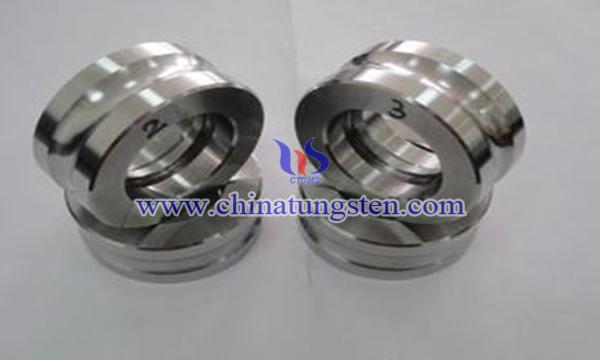Heat Treatment of Steel Bonded Tungsten Carbide Die
- Details
- Category: Tungsten Information
- Published on Friday, 13 April 2018 16:40
Steel bonded tungsten carbide is a new type of engineering material made of high speed steel or alloy steel powder as binder with one or more carbides as hard phase and powder metallurgy method. Because of its advantages of high hardness, high strength, high wear resistance, excellent chemical stability, high temperature resistance, corrosion resistance and excellent mechanical processing property, it has been widely used in die manufacturing industry.
In recent years, we have dealt with more steel bonded tungsten carbide dies and accumulated some experience. Now, the heat treatment technology is briefly introduced below for reference.

1, Annealing
After calcination, steel bonded tungsten carbide is difficult to be machined. So, it is necessary to anneal. The microstructure after annealing is hard phase, spherical pearlite and tungsten carbide. When annealing, the heating temperature should not be too high, and the holding time should not be too long, so as to prevent carbide aggregation from coarsening and stabilize. After annealing, although it still has high hardness which is about 40HRC, it can be machined.
2, Q-Tempering
The heat treatment of steel bonded tungsten carbide is not difficult. It can be quenched by ordinary hardening, graded quenching and isothermal quenching. Because the overheating sensitivity is small, the quenching heating temperature is wide, and it can be determined according to the chemical composition, performance requirements and the complexity of the die. The poor thermal conductivity of steel bonded tungsten carbide makes it necessary to heat the alloy for several times.
Double preheating at 600~650℃ and 800-850℃ is picked. And the heating coefficient is calculated by 2min/mm, when all the salt bath furnaces are used. In order to prevent oxidation and decarburization than pitting, salt bath furnace to fully deoxidation, slag. The high temperature heating coefficient is calculated at 0. 7-1.0min/mm, and the oil is quenched.
After quenching, it should be tempered in time, according to chemical composition and usage. When dies are worn, they should be tempered at low temperature. When the die is working under impact load, the tempering temperature should be increased appropriately, so as to get the best combination of strength and toughness. Steel bonded tungsten carbide is tempered at low temperature around 200℃, while a few of them are tempered at high temperature above 500℃, avoiding tempering brittle zone at 300 ~350℃. When tempering temperature is 500℃, there will be two hardening phenomena as high speed steel cutting tools. Therefore, tempering temperature should not be too high, which is one of the most important properties of steel bonded carbide, compared to other alloy tool steel.
- Tungsten Carbide Manufacturer & Supplier, Chinatungsten Online: tungsten-carbide.com.cn
- Tungsten News & Prices of China Tungsten Industry Association: www.ctia.com.cn
- Molybdenum News & Price: news.molybdenum.com.cn
- Tel.: 86 592 5129696; Fax: 86 592 5129797; Email: sales@chinatungsten.com



 sales@chinatungsten.com
sales@chinatungsten.com